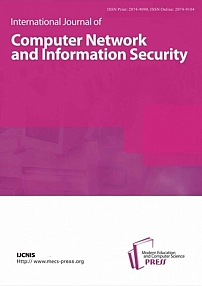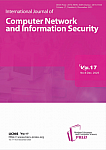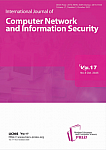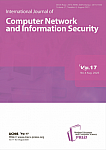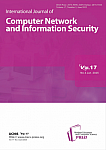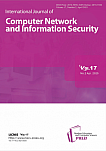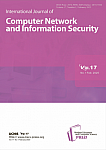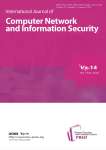International Journal of Computer Network and Information Security @ijcnis
International Journal of Computer Network and Information Security
International Journal of Computer Network and Information Security (IJCNIS) is a peer reviewed journal in the field of Computer Network and Information Security. The journal is published 12 issues per year by the MECS Publisher from 2012. All papers will be blind reviewed. Accepted papers will be available on line (free access) and in printed version. No publication fee.
IJCNIS is publishing refereed, high quality original research papers in all areas of Computer Network and Information Security.
IJCNIS has been indexed by several world class databases: Google Scholar, Microsoft Academic Search, CrossRef, DOAJ, IndexCopernicus, INSPEC(IET), EBSCO, VINITI, JournalSeek, ULRICH's Periodicals Directory, WordCat, Scirus, Academic Journals Database, Stanford University Libraries, Cornell University Library, UniSA Library, CNKI Scholar, ProQuest, J-Gate, ZDB, BASE, OhioLINK, iThenticate, Open Access Articles, Open Science Directory, National Science Library of Chinese Academy of Sciences, The HKU Scholars Hub, etc..
The journal publishes original papers in the field of computer network and information security which covers, but not limited to the following scope:
New generation network and its application
Network architectures and protocols
Network University
Network Curriculum
Computer Network Education
Computer Distance Learning
IPV6
Wireless Network
Wireless sensors networking
Grid Computing
Cloud computing
Cluster Computing
Distributed computing
Peer-to-Peer network
RFID Technologies
E-commerce protocols
E-Health
Intrusion Detection and Prevention
Biometric Security and Artificial Intelligence
Cryptography and security protocols
Authentication and Identification
Mobile System Security
Security in social networks
Security for web services
Sensor and Mobile Ad Hoc Network
Security for Web Services
Security for Personal Data and Databases
Piracy detection and tracing
Denial of Service and other attacks
Management of Computing Security
Intelligent Multimedia Security Services
Channel Modeling and Characterization
Modulation/Coding/Signal Processing
B3G Systems, WiMAX and WLAN
Authentication, Authorization and Billing
Applications and Services for B3G/4G era
Radio Resource Management
Network measurement and Management
Theory and Models of Trust
Trust computing
Education of network
Bayesian Networks, Fuzzy and Rough Set
Intrusion Detection and Prevention
Biometric Security and Artificial Intelligence
Cryptography and security protocols
Authentication and Identification
Bayesian Networks, Fuzzy and Rough Set
Mobile System Security
Ubiquitous Computing Security
Sensor and Mobile Ad Hoc Network Security
Security in Wireless Network
Security of GSM/GPRS/UMTS systems
Security for Grid Computing
Security for Web Services
Security for Personal Data and Databases
Peer-to-Peer Security
Risk Assessment
Modern Education & Computer Science Press
Выпуски журнала
Статьи журнала
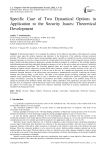
Статья научная
In the presented paper it is investigated the influence of the subjective perception of the objectively existing security values upon the security measures and indicators in the framework of the subjective entropy maximum principle. The subjective analysis theory entropy paradigm makes it possible to consider the security system based upon dynamic parameters as an active system governed by an individual (active element of the managerial system) with the help of her/his individual subjective preferences optimal distributions obtained in conditions of the available situation multi-alternativeness and those achievable alternatives presence, as well as the active system active element’s individual subjective preferences uncertainty. The described approach takes into account the simple two-alternative security situation in regards with the objectively existing effectiveness functions, related to security measures, in the view of a controlled parameter and a combination of it with its rate as the ratio. It is obtained the expressions for the objective functional extremal functions of the effectiveness and preferences, mathematically explicitly visualizing the security situation and allowing taking a good choice. The ideas of the required proper governing, managing, and control methods choice optimization with respect to only 2 alternative objective effectiveness functions arguments might be simple; nevertheless, increasing the number of parameters and further complication of the problem setting will not change the principle of the problem solution. This study is rather comparative. The significance and value of the study becomes clear in comparison with the theoretical results in the entropy paradigm field. Herein the solution obtained in the explicit view based upon the integral form objective functional. Such kind of dynamic optimization was not modeled in the background works.
Бесплатно
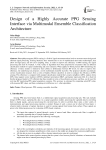
Статья научная
Photoplethysmogram (PPG) sensing is a field of signal measurement that involves accurate sensor design and efficient signal processing. Sensing interfaces have matured due to use of sophisticated nano-meter technologies, that allow for high speed, and low error sampling. Thus, in order to improve the efficiency of PPG sensing, the signal processing unit must be tweaked. A wide variety of algorithms have been proposed by researchers that use different classification models for signal conditioning and error reduction. When applied to blood pressure (BP) monitoring, the efficiency of these models is limited by their ability to differentiate between BP levels. In order to improve this efficiency, the underlying text proposes a novel multimodal ensemble classifier. The proposed classifier accumulates correct classification instances from a series of highly efficient classifiers in order to enhance the efficiency of PPG sensing. This efficiency is compared with standard classification models like k-nearest neighbors (kNN), random forest (RF), linear support vector machine (LSVM), multilayer perceptron (MLP), and logistic regression (LR). It is observed that the proposed model is 10% efficient than these models in terms of classification accuracy; and thus, can be used for real time BP monitoring PPG signal acquisition scenarios. This accuracy is estimated by comparing actual BP values with measured BP values, and then evaluating error difference w.r.t. other algorithms.
Бесплатно
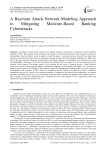
A Bayesian Attack-Network Modeling Approach to Mitigating Malware-Based Banking Cyberattacks
Статья научная
According to Cybersecurity Ventures, the damage related to cybercrime is projected to reach $6 trillion annually by 2021. The majority of the cyberattacks are directed at financial institutions as this reduces the number of intermediaries that the attacker needs to attack to reach the target - monetary proceeds. Research has shown that malware is the preferred attack vector in cybercrimes targeted at banks and other financial institutions. In light of the above, this paper presents a Bayesian Attack Network modeling technique of cyberattacks in the financial sector that are perpetuated by crimeware. We use the GameOver Zeus malware for our use cases as it’s the most common type of malware in this domain. The primary targets of this malware are any users of financial services. Today, financial services are accessed using personal laptops, institutional computers, mobile phones and tablets, etc. All these are potential victims that can be enlisted to the malware’s botnet. In our approach, phishing emails as well as Common Vulnerabilities and Exposures (CVEs) which are exhibited in various systems are employed to derive conditional probabilities that serve as inputs to the modeling technique. Compared to the state-of-the-art approaches, our method generates probability density curves of various attack structures whose semantics are applied in the mitigation process. This is based on the level exploitability that is deduced from the vertex degrees of the compromised nodes that characterizes the probability density curves.
Бесплатно
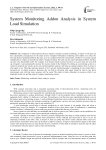
System Monitoring Addon Analysis in System Load Simulation
Статья научная
The complexity of interconnected devices requires constant real-time monitoring, as failure of one part can have catastrophic consequences for the entire system. Computer-information monitoring tools enable us to always be one step ahead of potential problems that may occur in a monitored network environment, whether it is a human-caused configuration or simply an element has failed or stopped working. Not only can they report potential problems, but they can also solve the problem itself. For example, if an element needs increased resources at a given time, the tool itself can recognize it and automatically increase the resource needs of that element. By setting up a monitoring system in a virtual environment, the results can be seen and through their analysis will bring an optimal solution when it comes to what agent to use. This paper presents analysis of how network monitoring agent is responding in cases when there is increased use of shared resources. Knowing this can help in choosing what agent should be used in any given environment, and with that more resources will be saved. This leads to better utilization of resources which is an important in mid-size and big setup of computer monitoring systems.
Бесплатно
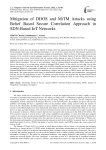
Статья научная
In recent years the domain of Internet of Things (IoT) has acquired great interest from the ICT community. Environmental observation and collecting information is one of the key reasons that IoT infrastructure facilitates the creation of many varieties of the latest business methods and applications. There are however still issues about security measures to be resolved to ensure adequate operation of devices. Distributed Denial of Service (DDoS) attacks are currently the most severe virtual threats that are causing serious damage to many IoT devices. With this in mind, numerous research projects were carried out to discover new methods and develop Novel techniques and solutions for DDOS attacks prevention. The use of new technology, such as software-defined networking (SDN) along with IoT devices has proven to be an innovative solution to mitigate DDoS attacks. In this article, we are using a novel data sharing system in IoT units that link IoT units with the SDN controller and encrypt information from IoT unit. We use conventional Redstone cryptographic algorithms to encrypt information from IoT devices in this framework. The Proposed Belief Based Secure Correlation methodology supports the prevention of DDOS attacks and other forms of data attacks. The system proposes new routes for transmission through the controller and communicates with approved switches for the safe transmission of data. To simulate our entire scenario, we proposed the algorithm Belief Based Secure Correlation (BBSC) implemented in SDN–IoT Testbed and verified IoT data is secure during transmission in the network.
Бесплатно

